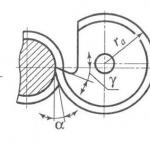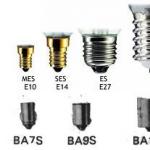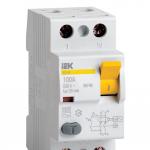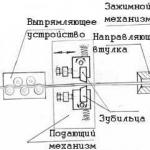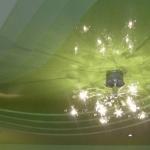The garage is not only a protected parking lot for your "iron horse", but also a place where you can repair it. Therefore, it is very important that the garage is well lit. But here certain difficulties may arise due to the frequent absence of wiring and banal electricity in such buildings. Such difficulties often arise when the garage building was erected by hand and away from the power line.
Lighting in the garage
In such a situation, it will be relevant to make autonomous garage lighting. What you need to know to make such lighting with your own hands, our today's article will tell you.
How is lighting done?
During the construction of any premises, lighting systems should always be laid down at the planning stage. This is especially important for buildings such as a garage, which you can build with your own hands without any problems. Before making autonomous lighting in this room, you need to consider the following points:
- what level of lighting you need to organize;
- what lighting fixtures will be used;
- what kind of light source will be screwed into the fixtures.

garage lighting option
It must be remembered that garage lighting, even an autonomous plan, must necessarily meet the following rules:
- be safe. Autonomous lighting in this case will be the most relevant, since in this case there is no wiring, which means there is a risk of electrical injury;
Note! Using an LED lamp with a power of 12 volts for illumination, you can not only illuminate the premises with high quality, but also completely eliminate the risk of electrical injury.
- The level of illumination should be comfortable for the eyes. In order to correctly calculate the level of illumination for a given room, it is necessary to rely on the standards given in the SNiP for garages;
- the light that the fixtures will create should illuminate the entire space, including the corners. However, it must be balanced. To achieve this level of illumination, you can use the general and local type of illumination;
- placement of lighting fixtures should be carried out according to a scheme convenient for you. This will make working in the garage more convenient and comfortable.
Another important factor that must be taken into account when creating autonomous lighting in garage-type structures is the economical consumption of electricity. In this situation, the LED lamp of any model (especially low-power 12 volts) has proven itself most effectively.

12 volt LED lamp
The fact is that such devices, with a power of only 12 volts, are capable of producing a bright light flux and at the same time consuming a minimum amount of energy.
Note! If you wish, you can make a homemade LED lamp and thereby save on buying a factory lamp.
To create autonomous lighting with your own hands, such a lamp is the best fit.
Autonomous garage lighting options
As already mentioned, LEDs will be the best choice for any garage structures. They have a lot of advantages, among which the following points should be highlighted:
- creating uniform and bright lighting;
- according to the intensity of the glow, such a lamp creates a luminous flux, which is equivalent to daylight;
- economical use of electricity;
- such lighting devices can be powered from various devices (for example, from a battery) in a situation where there is no source of electricity.

Most often, 12 volt LED strips are used to illuminate garage premises. With its help, you can create general lighting by running a tape around the perimeter of the structure. In such a situation, the light coming from the tape will fall evenly. With the help of LED strip, you can also create local illumination of shelves and racks, as well as a viewing hole.
Note! To illuminate the viewing hole, a lamp or LED strip must be purchased with a high moisture resistance class. This is due to the fact that there is always high humidity due to poor ventilation and lack of heating.
The same conditions and requirements are typical for the basement. In this regard, the lighting installation that will be used here should not have a power higher than 12 volts.
The fact that in certain places of the garage you need to install a waterproof lamp must be remembered, both when creating autonomous lighting and in the presence of electricity.
Autonomous garage lighting and how to implement it
In the garage, autonomous lighting is necessary in a situation where there is no electricity on the site or there are frequent interruptions with it. Therefore, in order to always have light in the garage, many car owners make autonomous lighting.
Note! Two types of lighting can be arranged in the garage: from a 220-volt power supply and autonomous lighting. In this case, autonomous lighting in this situation will already be called emergency. But this approach is relevant only when the main coverage has already been done earlier, and problems with it have appeared relatively recently.

Garage lighting
Today, there are many ways to make autonomous garage lighting with your own hands. The most popular among car owners are the following ways to organize light in the garage without electricity in it:
- placement of solar panels;
- installation of a wind generator;
- purchase of a gasoline generator;
- battery usage;
- garden lamp;
- Philippine lantern.
For a better understanding, let's consider each method of highlighting in more detail.
Lighting with solar panels
Today, many people install solar panels in their private homes and even apartments. With their help, you can not only save on electricity, but also light up a garage in which there is no electricity.

Solar garage lighting
Despite the popularity of this method of illumination, it is unlikely to be suitable for a garage for the following reasons:
- the cost of one solar battery and its connection will cost a significant amount;
- it is unlikely that it will be possible to install such a system with your own hands without the help of specialists;
- the complexity of the system for connecting lighting fixtures and batteries to storage equipment (batteries).
But having once spent on the purchase and installation of solar panels, you will not only receive high-quality autonomous lighting of any room, including the garage, but you will also be able to sell the excess electricity that has accumulated to the state.
A 12 volt lamp can be powered from such a system. At the same time, their number can reach several pieces, which is just right for this room. If there is a need for a voltage of 220 volts, then this system needs a 12 volt converter or inverter.
Lighting with a wind generator
For autonomous garage lighting, you can use a homemade wind generator. Such a windmill will also generate free electricity, from which you can power a 12 volt lamp.
Note! You can either make a windmill with your own hands or buy a ready-made device. However, a purchased wind generator will cost a tidy sum.

Homemade wind generator
When creating this type of backlight, wind speed must be taken into account. In a situation where strong winds are rare in the area of residence, then this method of lighting will be ineffective. Here, all the costs that went to the installation of a wind generator will not pay off.
Illumination with a gasoline generator
Instead of a wind generator, you can use a gasoline or diesel generator to create an autonomous garage lighting.

gasoline generator
It is rational to use a gasoline generator only when problems with electricity are rare, and the light is turned off for a short period of time. It is also rational to purchase it if you often use power tools in the garage.
Batteries and their applications
Another way to create an autonomous backlight in a garage building is to connect the lamps to the battery. The battery can power the lamp at 12 volts.

car battery
When the light is turned off, such a lighting device (designed for 12 volts) can work for 10 hours. Of course, if before that the battery was fully charged.
You can use a spare car battery to illuminate your garage. With it, it is best to feed the LED strip, which can be run around the entire perimeter of the premises.
Lighting with garden lights
Many today use garden solar lamps to illuminate the garden at night. During the day, they accumulate enough energy to efficiently illuminate the garden paths of the flower beds. But, as practice shows, they can also be used to illuminate the garage when there are problems with electricity.

Solar Garden Lights
They should be charged on the street, and as soon as there is a need for such lighting fixtures, they are brought inside the garage. Usually they give light for 5-6 hours. But such a period of work is typical for high-quality lamps.
The disadvantage of using garden lights with solar panels is that over time the brightness of the light they provide will decrease. But this parameter is typical for any type of backlight of an autonomous type, which is powered by drives.
Illumination with a Philippine lantern
In addition to the above-mentioned method of autonomous lighting of garage buildings, some motorists use the so-called "Philippine lantern".

Philippine lantern
This method makes it possible to organize free lighting in the garage. And it is quite possible to do it yourself. Philippine lantern operates on the principle of refraction of light. You can make such a lantern from an ordinary plastic bottle. At the same time, it can be used as a whole, and a part of it can be cut out of it.
The algorithm for making a Philippine lantern with your own hands is as follows:
- a transparent plastic bottle is taken;
- the container is well washed and cleaned of the colored label;
- we put on it a rectangular or round screen made of stainless steel or galvanized steel;
- pure water is poured into the bottle. It must be diluted with bleach. This will avoid liquid bloom and, as a result, a drop in light intensity;
- the liquid is poured in such a way that its level is three centimeters higher than the installed screen;
- further, such a bottle is mounted in the roof of the garage structure. The bottle itself must be mounted on a rigid base.

Philippine lantern installation
If the roof was made of corrugated board, then simply cut a hole of the desired diameter in the sheet of material. To minimize the risk of the roof leaking through the holes, all joints of the bottle with the roof must be well treated with silicone or sealant.
You can use the Philippine lantern as an additional autonomous lighting for the garage in those regions where the sun shines most of the year. To increase the level of illumination, you can install several of these homemade flashlights. In cloudy weather, such a design will give such a dim light that it will be life-threatening to work with it.
In addition, it is worth noting that if the manufacturing sequence of the Philippine lantern is violated, the lighting inside the garage will also be poor.
Conclusion
To create autonomous lighting in the garage today, there are many opportunities. Some options will be quite expensive but very efficient (like installing solar panels or buying a gasoline generator), and some will be cheaper but less efficient (like using solar-powered garden lights). But if you approach the solution of this problem competently, then you can choose the most optimal method from all the available backlight options and stop depending on electricity, which is supplied intermittently.
A garage for many men is not only a covered parking space, but also a full-fledged workplace.
Car enthusiasts spend many hours of their lives in it every day, and not only for repair work. Windows in such places are not provided, so full-fledged lighting comes to the fore here.
There is either a mass of obstacles with documents, or there are simply no such electrical networks nearby. But do not be upset, because there are several simple ways to light up your garage building, even without power lines nearby.
First of all, you should decide on the following points:
- what lights will be used
- what bulbs will be in these lamps
- how much light do you need
First, the fixtures should be economical. After all, you will not have a power line nearby from which you can safely take a few kilowatts. Therefore, the best option would be low-power LED models or 12 volt bulbs.
Even with such a supply voltage, they are quite capable of producing a full-fledged luminous flux no worse than 220V incandescent lamps. Lighting from them will be bright and uniform.
At the same time, energy consumption from an autonomous power source will be reduced to a minimum. They can be powered from batteries of minimum power. Not necessarily from automotive ones, even used computer UPSs will do.
Light bulbs of different power for a regular 12V E27 cartridge can be ordered from the Chinese here.
You can also use an LED strip as a backlight. If you stick it around the perimeter of the room, or with ribbons of several stripes in the center, you will get a general uniform lighting.
Also, pieces of such a tape can be glued into an old spotlight, taking only the body from under it. Thanks to the reflector, the lighting will be more than bright, and the consumption will be minimal.
It is convenient to organize local illumination of a workplace or an inspection hole with short pieces of tape.
Just don't forget about humidity. Because of it, for me you need to buy not a simple tape with IP20 protection, but models with an increased moisture protection class.
The same applies to the cellar. In general, the use of U \u003d 12V lighting in such places is the only correct solution. If it is not a tape, but a lamp, then it must also be chosen with moisture protection.
When you have decided on the light sources, then you need to make a choice from what they will receive power from.
Let's make a reservation right away that we will not seriously consider such exotic species as solar panels, wind turbines or a Philippine lantern.
Although panels and windmills are no longer a rarity in our stores, few people dare to install a solar panel on the roof of a garage away from their home.
The factor of theft and vandalism cannot be ignored here. Moreover, such sources have a bunch of disadvantages:
3 Ways to Light a Garage Without Electricity
How to make lighting in a garage without electricity in a few minutes. Which is better, LED strips or 12V light bulbs. Rechargeable light, everything you need to know. Why not without a voltmeter.
Installation of solar panels
Whatever one may say, the most effective way is to install solar panels, thanks to which you can not only make autonomous lighting in the garage, but also provide independent power supply to the entire site. Yes, this is a costly option and you certainly cannot do without the help of specialists in installation. However, once you spend money, you can not only turn on the light when there is a power outage, but also significantly save electricity bills.
We talked about how to install solar panels with your own hands. If your budget allows, seriously consider this option.
Homemade wind generator
An alternative option for autonomous power supply to the garage and the cottage as a whole is to install a windmill, which can also generate free electricity. You can buy a ready-made device, but it will be quite expensive. For a 2-kilowatt model, you will have to pay about 100 thousand rubles. That is why we suggest you make a wind generator with your own hands, thanks to which you can use the light in the garage without electricity.
The only thing to consider is wind speed. If there are no strong gusts of wind in your region or the location of the site, it is unlikely that you will be able to get free electricity.
Diesel or petrol generator
You can also make the light in the garage without electricity, if you use a gas generator. In this case, as in the option with solar panels, it is possible to fully provide the site with electricity by connecting the generator to the mains. It is rational to use such an idea only if the light is turned off for a short period of time, and if you use a power tool in the garage.
Otherwise, 1 kW of electricity from a gas generator will cost you quite a lot, so it is unlikely to be profitable to use it all the time. We talked about how to connect the generator to the network in the corresponding article.
Battery application
LED lamps with battery
On the Internet, you can now find many offers for the sale of battery-powered LED lamps. A battery is installed inside the 5-12 watt bulbs, which is able to maintain autonomous lighting for 6-12 hours.
Using such a lamp is quite simple - it is screwed into a standard E27 cartridge, charged from the mains throughout the day, after which it can provide lighting in the garage without electricity. The cost is about 600 rubles, so you can buy 2 light bulbs and forget about problems with power outages.
Garden solar lights
A similar idea is to purchase solar-powered garden lights, place them in the open air on the territory, and in the evening, if the lights turn off, bring them into the garage. Such lighting devices will last for 5-6 hours, if they are of high quality.
The only drawback is that over time, the brightness of the lighting will fall, in fact, as well as the time of autonomous lighting. However, many people use this idea, so there are reasons for its existence.
Philippine lanterns
Well, the last way that allows you to make free light in the garage during the daytime is the use of Philippine lanterns, which work on the principle of light refraction. Making a Philippine lantern with your own hands is quite simple - a part of the bottle is cut out (although you can use the whole one), mounted on a rigid base and mounted in the roof. If the roof is made of corrugated board, you can simply cut a suitable hole in the sheet into which a water bottle is installed, as shown in the photo below:
To prevent rain from getting inside the garage, the joints between the roofing material and the bottle must be well sealed with sealant. This idea is suitable for residents of regions in which sunny weather prevails. Otherwise, the light will be dim and nothing will work. If you do everything right, the result will be something like this:
So we have listed all the popular ways to make the light in the garage without electricity. Our opinion is that if you really need only autonomous lighting, and not full power supply, it is better to purchase battery-powered LED lamps or make a windmill with your own hands. All other technologies are either too expensive or not effective enough.
Autonomous garage lighting - 7 simple ideas
How to make a light in the garage if there is no electricity? 7 ideas for organizing autonomous lighting inside the garage with your own hands.
We have already talked about how to connect the lighting in the garage. Of course, everything is written there well and clearly, but there are times when it is not possible to use electricity. This may be its complete absence or permanent shutdown, in any case, it is unpleasant. Therefore, in this article we decided to tell you how to make lighting in a garage without electricity, tell you the main methods and talk about those that you should not choose at all.
What better not to do
Solar panels
They can be called a modern way that can really bring results. But, if you use solar panels in the garage, it can be called a disaster. Let's just remember how much average batteries cost now, in order to light a garage and get electricity, for certain work, you will have to pay about 5 thousand dollars for their purchase and installation.
Such an amount is considered unacceptable, even if you find it in the garage all the time. They also need to be constantly wiped from dust and monitor their condition. And of course, there is a very high probability that they will simply be stolen.
Windmill for garage
The method is good, but only in those regions where there is a strong constant wind. To get electricity for the operation of devices, you need a wind of 6 m / s. Light wind can provide light, but there are easier ways.
solar lanterns
Here we will simply write the two main drawbacks:
- They shine dimly.
- Constantly need to be taken out to the street for a charge, they also quickly fail.
This option should be forgotten.
How to make garage lighting without electricity: effective ways
Here we will tell you a few basic ways, all of them have already been tested in practice. Each of them is working, but has its own certain pluses and minuses, let's try to analyze each one separately. Learn how to light garden paths.
Finnish lantern
This method is suitable only for those who do not have the opportunity to open the doors on a sunny day. Installation is easy, here's what it looks like.
The result is good, but only in sunny weather. Think over this option in advance, you will have to break the wall, and this is already a disaster.
car battery
You can safely use the old 65 A / h battery. We connect ordinary 12 Volt LED strips or spotlights to it. Such light sources are considered economical, if you need a light, just turn it on and everything starts working right away.
This is how we connect the tape to the battery, do not forget to observe the polarity.
- Good light, if desired, you can add bulbs.
- An old battery is cheap.
- Connecting everything together is easy.
- The battery will have to be constantly charged, dragging home.
- It will fail in a year or two.
Also, light in a garage without electricity can be made using a 2 kilowatt gas generator. It is enough to make lighting or work with tools. This method can be called optimal. Of course, now the cost of generators is serious, but if you often find it in the garage, then you simply cannot do without it.
Combined Garage Lighting System
The essence of this method is quite simple, we connect the generator and charge the battery from it. The battery is connected to the LED strip and makes lighting, you need to charge infrequently.
If you need to turn on the tools, then just start the generator and enjoy all the benefits. You can come up with a few more applications, if you have your own ideas, leave them as a comment on this article.
How to make garage lighting without electricity
In this article, you will learn how to make do-it-yourself garage lighting without electricity. We will tell you the main methods and options for connecting.
Autonomous lighting in the country can be an alternative to centralized power supply in cases where in the future it is impossible to connect to the mains at all, or the cost of connection is incredibly high and troublesome. Also, the use of various options for autonomous lighting in the country is being pushed by ever-increasing electricity tariffs. Consider the two most popular options for energy supply and analyze which one is more profitable - these are: inverter gas generator And battery converter .
Inverter gas generator
Currently, an inverter gas generator is very popular for providing autonomous lighting in the country. This is explained by the fact that the unit is quite affordable, easy to operate, does not require special configuration and installation. All actions necessary for its functioning are as follows: installed, filled with fuel, started and received electricity. Everything, it would seem, is simple, however, in order to determine the appropriateness of its application, we will analyze all aspects of this issue.
Take as an example a Chinese-made Werk IG-2600 generator, which produces 2.3 kW of power and costs about 22,000 rubles. Fuel consumption at rated power is 0.9 l / h (according to the passport). For convenience of calculation, the cost of fuel is equated to the price of AI-92 gasoline, which is equal to 36 rubles / liter. To determine the cost of one kW / h, we will perform the following actions: 1 kW / h \u003d 36 rubles / liter x 0.9 liters / hour: 2.3 kW \u003d 14.0 rubles.
The value is 14.0 rubles. for one kW - this is, in principle, not bad, but we must not forget that 22,000 rubles were paid for the Werk IG-2600 inverter gas generator. And if we take the motor resource of this device equal to 5000 hours, then we can get the final cost of one kW / hour. For this, 22,000 rubles. : 5,000 hours and get 4.4 rubles. Now, in total, one kWh will cost: 14.0 + 4.4 = 18.4 rubles. If we take electricity tariffs in Moscow, which are equal to 5.38 kW / h, then we can see that the cost of autonomous lighting in the country will be approximately 3.4 times higher.
It is profitable or not, everyone decides for himself, based on his cash income. Now many generator manufacturers are reducing the cost of one kilowatt by creating devices that run on both gasoline and liquefied gas, which is twice as cheap as gasoline.
Battery Converter
The battery inverter converter consists of powerful batteries with a voltage of 12 - 24 Volts and a special device that converts DC voltage to AC 220 Volts. Therefore, it is necessary to pre-charge the batteries from a stationary power grid in order to use this supply of electricity in the country later. It should be noted right away that ordinary car batteries are unsuitable for this purpose, since they give out a large current only for a certain period of time and cannot power the converter for a long time.
Therefore, batteries for an inverter will be four times more expensive than car batteries of the same capacity, but their service life is up to ten years, which cannot be said about car batteries. Therefore, the cost of a battery converter consisting of two batteries with a capacity of up to 300 Ah will be about 150,000 rubles.

To determine the profitability of such an installation in the country, we first give the formula for the required battery capacity depending on the power consumption. The formula looks like this: E \u003d N t efficiency / U. Where E is the required capacity in A / h, t is the battery discharge time, N is the power consumption in W, efficiency is the safety factor, the value is equal to 0.7 and U is the voltage battery volts.
Now let's calculate what the battery capacity should be with a battery discharge time of 5 hours in order to provide a consumer power equal to 2,000 watts. For this, 2,000 5 0.7: 12 = 583 Ah. Installations usually have two batteries, so the capacity of one should be 583:2 = 291 Ah ≈ 300 Ah. Which corresponds to the cost of the entire unit of 150,000 rubles.
If we took a time of 10 years for the battery life, then it will take 27,000 kW / h to recharge it during this period at a price of 5.38 rubles per kilowatt. That is, 27,000 5.38 \u003d 145,260 rubles will be spent. Moving on: the total cost of all costs is now 145,260 + 150,000 = 295,260 rubles.
Mean the cost of one kilowatt when using a battery converter will be equal to: 295,260: 27,000 = 10.9 rubles. That is, it is now clear that this is almost two times less than the cost of one kilowatt of electricity than when using an inverter gas generator to provide autonomous lighting in the country.
It is clear that these calculations are tiring, but without them, a comparison of these two installations would be unfounded. As a result, it is up to you to decide which installation and at what price to purchase, based on financial capabilities.
A garage for many men is not only a covered parking space, but also a full-fledged workplace.
Car enthusiasts spend many hours of their lives in it every day, and not only for repair work. Windows in such places are not provided, so full-fledged lighting comes to the fore here.
However, therein lies the main problem. Connecting your garage to the mains seems to be an insoluble problem for most.
There is either a mass of obstacles with documents, or there are simply no such electrical networks nearby. But do not be upset, because there are several simple ways to light up your garage building, even without power lines nearby. 
Selection of fixtures
 First of all, you should decide on the following points:
First of all, you should decide on the following points:
- what lights will be used
- what bulbs will be in these lamps
- how much light do you need
 First, the fixtures should be economical. After all, you will not have a power line nearby from which you can safely take a few kilowatts. Therefore, the best option would be low-power LED models or 12 volt bulbs.
First, the fixtures should be economical. After all, you will not have a power line nearby from which you can safely take a few kilowatts. Therefore, the best option would be low-power LED models or 12 volt bulbs. 
Even with such a supply voltage, they are quite capable of producing a full-fledged luminous flux no worse than 220V incandescent lamps. Lighting from them will be bright and uniform.
At the same time, energy consumption from an autonomous power source will be reduced to a minimum. They can be powered from batteries of minimum power. Not necessarily from automotive ones, even used computer UPSs will do. 
Bulbs of different power for a regular E27 12V cartridge can be ordered from the Chinese here.
You can also use an LED strip as a backlight. If you stick it around the perimeter of the room, or with ribbons of several stripes in the center, you will get a general uniform lighting. 
Also, pieces of such a tape can be glued into an old spotlight, taking only the body from under it. Thanks to the reflector, the lighting will be more than bright, and the consumption will be minimal. 
It is convenient to organize local illumination of a workplace or an inspection hole with short pieces of tape. 
Just don't forget about humidity. Because of it, for me you need to buy not a simple tape with IP20 protection, but models with an increased moisture protection class. 
The same applies to the cellar. In general, the use of U \u003d 12V lighting in such places is the only correct solution. If it is not a tape, but a lamp, then it must also be chosen with moisture protection. 
When you have decided on the light sources, then you need to make a choice from what they will receive power from.
Let's make a reservation right away that we will not seriously consider such exotic species as solar panels, wind turbines or a Philippine lantern.
Solar panel and wind generator
 Although panels and windmills are no longer a rarity in our stores, few people dare to install a solar panel on the roof of a garage away from their home.
Although panels and windmills are no longer a rarity in our stores, few people dare to install a solar panel on the roof of a garage away from their home.
The factor of theft and vandalism cannot be ignored here. Moreover, such sources have a bunch of disadvantages:
- high price


- direct dependence on weather conditions
Philippine lantern lighting
 The Philippine lantern for our latitudes is generally a rare exotic, little known to anyone. It has one advantage - it is absolutely free.
The Philippine lantern for our latitudes is generally a rare exotic, little known to anyone. It has one advantage - it is absolutely free.
The name of the flashlight comes from the places where it was actually invented. By the way, a whole volunteer organization with a very telling name - “Liter of Light” is engaged in such lighting there.
Everything is based on the refraction of natural light from the sun. Such a flashlight is made from a plastic bottle filled with water. 
The production order is as follows:
- the bottle is thoroughly washed to a shine, all labels are removed
- a rectangular stainless steel screen is put on top
- bottled water is diluted with bleach or bleach. These components are needed so that the liquid does not bloom and does not have to be changed frequently.
- the bottle needs to be filled with water 3 cm above the screen itself
- a hole is drilled in the roof, where such a lamp is fixed
To avoid leaks, all joints are sealed with silicone. 
One such flashlight is comparable in terms of lighting power to a 50-watt incandescent bulb and covers an area of up to 10m2.
In order to raise the level of illumination, you will have to mount several such devices on the roof. 
However, you need to be objective, this way of lighting is more applicable to some shed with trash than a garage where a car worth several thousand dollars is stored. No one in their right mind would hole their roof for a bottle of water.
Power supply from a generator
One of the common cases of garage lighting is the purchase of a gasoline or diesel generator. Here you can get by with models of the most minimal power up to 1 kW. 
In addition, if absolutely necessary, all power tools in the garage can be easily connected from such a power plant - a grinder, a drill, a small emery, etc.
However, the disadvantages here can not be avoided:
- traffic fumes
- constant noise and rattling
- starting problems in winter
- complaints from neighbors who will be inconvenienced by all this
battery lighting
Having filtered out the original and inapplicable options, let's turn to the most popular power source for lighting in the garage. As such, the 12V car battery still remains. The capacity is suitable for the most common - 55Ah. 
For LED light bulbs or ice tape, one charge in a gentle mode can last more than 10 hours of continuous operation and even more. 
Naturally, this should be a separate battery, and not the one used in your car. After a voltage drop, the battery will have to be carried home for recharging.
When using rechargeable batteries, always watch the discharge voltage.
Most batteries after a drawdown of less than 10-10.5V are already difficult to recover for full operation. 
Therefore, for monitoring, always put a miniature digital voltmeter in parallel in the power circuit.
1 of 2


You can also use terminals with a built-in digital voltage meter. 
Naturally, all lighting, even though it is 12V, will need to be connected through protection devices - 5-10A circuit breakers.
The most effective such lighting is organized on the basis of LED strips. 
Here is a good video of how a man assembled almost full-fledged lighting in his country house using an LED strip and a battery, and used it for several months.
Some assemble similar circuits based on a battery and an inverter. But why waste the initial energy also on the operation of the converter? 
When you already have light bulbs or a 12V Led strip, it is much easier and cheaper to immediately connect them from this voltage.
If you need to light up not the entire garage, but only certain areas, then ordinary lithium-ion batteries can handle this. You don't even have to buy a battery.
How to assemble such a design and how long this backlight will last can be found in the article below. 
Those who do not have the desire to carefully make a circuit, lay wires, can generally assemble all garage lighting literally “on their knees”.
Take a used battery from the UPS. On a thick cardboard, mount a minivoltmeter and an on / off button. 
Then you connect LED strips from this design - daytime running lights. This design is especially justified in cellars and small rooms. 
It is necessary to use running lights, because they are initially waterproof. All contacts and connections should preferably be insulated.
Here is a video on how to assemble such lighting in a few minutes.
Bulb with built-in battery
Well, the easiest option would be to use LED bulbs with a built-in battery. 
Hang the cartridges in places where you need to get more light. You screw the lamps into them and that's it.
No wires, voltage level control, protection devices, etc. One such bulb can work up to 12 hours. Produced luminous flux up to 500lm. 
After that, unscrew it and take it home. There, again screwing into the cartridge, which is under voltage of 220V, you recharge it.
The cost of such lighting will be the most economical.
Provide lighting for a room in a country house, connect a garage or other object to the light without access to a centralized power grid? In principle, this is real in the presence of a battery. But what, where and for how much to buy a power source, we will talk further.
The task when the dacha is located several hundred kilometers from the city, there is no electricity on it, and there will be no electricity in the near future, but you want light, is not so rare. And even in the presence of a generator, it is not so easy to solve, because a rather strong noise comes from the unit, and it consumes a lot of fuel. Usually in such cases, buy a battery. Moreover, choosing it, you need to remember that the power source must meet the following criteria:
- Be not very heavy.
- Have a high capacity.
- Charge fast.
- Worked for the longest time.
- It was relatively inexpensive.
- Not afraid of deep discharges.
Of the possible solutions to the problem, the following comes to mind: first of all, these are cargo batteries. But they are too heavy. There are also traction batteries. This is a better option. However, their cost is 5-6 thousand rubles. Otherwise, such batteries meet absolutely all the criteria indicated above. It is light, compact, perfectly withstand repeated discharges and charges. These are the so-called "full cycle" batteries. They are produced by many manufacturers, but today we offer you to get acquainted with the line of Bosch L-series traction batteries. For their production, two well-proven technologies are used. These are, among others, DEEP CYCLE and DEEP CYCLE AGM. Their advantages are obvious:
- Top performance. To illuminate a small room, one charge is enough for several days.
- Unpretentiousness to operating conditions. Batteries of this series can work at any temperature conditions.
- Essential capacitive characteristics. With a small mass, the batteries have a capacity of 75, 100 or more Ampere hours.
- Long-term operation in cyclic mode at full discharges. Even multiple critical discharges are not able to disable the battery, because it is designed with such operating modes in mind.
- Low level of self-discharge. Leaving the battery for several months, it can be immediately connected to consumers - the light bulb will burn as brightly as before it was turned off.
- Compact body sizes. This is very convenient when considering the country option for using batteries.
These properties make it possible to say that L-types are excellent for solving the problem of organizing lighting at those facilities where there is no centralized power supply system. By the way, about the price. A battery with a capacity of 100 ampere hours costs about 6-7 thousand rubles, which is comparable to the cost of a conventional starter power supply. Therefore, the high cost of full-cycle traction batteries is nothing more than a myth.




